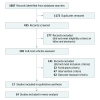Clinical Evidence for Association of Acupuncture and Acupressure With Improved Cancer Pain: A Systematic Review and Meta-Analysis
- PMID: 31855257
- PMCID: PMC6990758
- DOI: 10.1001/jamaoncol.2019.5233
Clinical Evidence for Association of Acupuncture and Acupressure With Improved Cancer Pain: A Systematic Review and Meta-Analysis
Abstract
Importance: Research into acupuncture and acupressure and their application for cancer pain has been growing, but the findings have been inconsistent.
Objective: To evaluate the existing randomized clinical trials (RCTs) for evidence of the association of acupuncture and acupressure with reduction in cancer pain.
Data sources: Three English-language databases (PubMed, Embase, and CINAHL) and 4 Chinese-language biomedical databases (Chinese Biomedical Literature Database, VIP Database for Chinese Technical Periodicals, China National Knowledge Infrastructure, and Wanfang) were searched for RCTs published from database inception through March 31, 2019.
Study selection: Randomized clinical trials that compared acupuncture and acupressure with a sham control, analgesic therapy, or usual care for managing cancer pain were included.
Data extraction and synthesis: Data were screened and extracted independently using predesigned forms. The quality of RCTs was appraised with the Cochrane Collaboration risk of bias tool. Random-effects modeling was used to calculate the effect sizes of included RCTs. The quality of evidence was evaluated with the Grading of Recommendations Assessment, Development and Evaluation approach.
Main outcomes and measures: The primary outcome was pain intensity measured by the Brief Pain Inventory, Numerical Rating Scale, Visual Analog Scale, or Verbal Rating Scale.
Results: A total of 17 RCTs (with 1111 patients) were included in the systematic review, and data from 14 RCTs (with 920 patients) were used in the meta-analysis. Seven sham-controlled RCTs (35%) were notable for their high quality, being judged to have a low risk of bias for all of their domains, and showed that real (compared with sham) acupuncture was associated with reduced pain intensity (mean difference [MD], -1.38 points; 95% CI, -2.13 to -0.64 points; I2 = 81%). A favorable association was also seen when acupuncture and acupressure were combined with analgesic therapy in 6 RCTs for reducing pain intensity (MD, -1.44 points; 95% CI, -1.98 to -0.89; I2 = 92%) and in 2 RCTs for reducing opioid dose (MD, -30.00 mg morphine equivalent daily dose; 95% CI, -37.5 mg to -22.5 mg). The evidence grade was moderate because of the substantial heterogeneity among studies.
Conclusions and relevance: This systematic review and meta-analysis found that acupuncture and/or acupressure was significantly associated with reduced cancer pain and decreased use of analgesics, although the evidence level was moderate. This finding suggests that more rigorous trials are needed to identify the association of acupuncture and acupressure with specific types of cancer pain and to integrate such evidence into clinical care to reduce opioid use.
Conflict of interest statement
Figures



Comment in
-
Association of Acupuncture and Acupressure With Improved Cancer Pain.JAMA Oncol. 2020 Jun 1;6(6):939-940. doi: 10.1001/jamaoncol.2020.0622. JAMA Oncol. 2020. PMID: 32324193 No abstract available.
-
Association of Acupuncture and Acupressure With Improved Cancer Pain-Reply.JAMA Oncol. 2020 Jun 1;6(6):940. doi: 10.1001/jamaoncol.2020.0640. JAMA Oncol. 2020. PMID: 32324196 No abstract available.
-
Association of Acupuncture and Acupressure With Improved Cancer Pain.JAMA Oncol. 2020 Jun 1;6(6):938-939. doi: 10.1001/jamaoncol.2020.0619. JAMA Oncol. 2020. PMID: 32324200 No abstract available.
-
Association of Acupuncture and Acupressure With Improved Cancer Pain.JAMA Oncol. 2020 Jun 1;6(6):938. doi: 10.1001/jamaoncol.2020.0616. JAMA Oncol. 2020. PMID: 32324212 No abstract available.

